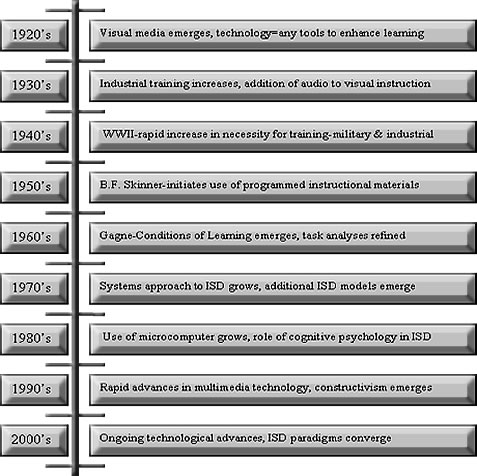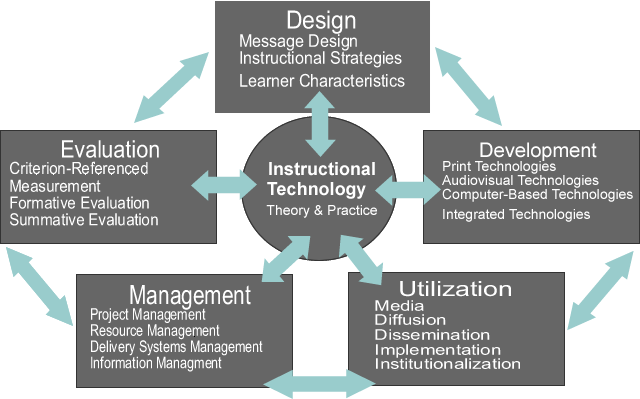
History & Definition of Instructional Technology
The term technology may lead individuals to assume that instructional technology is the use of computers in teaching and learning. With the ubiquity of computer technology hardware and software may be utilized as an instructional delivery system. However, Instructional Technology involves much more than using computers for learning.
Technology, as defined by the Merriam-Webster Dictionary states that technology is:the practical application of knowledge especially in a particular area (Merriam-Webster, 2006). By merging the definition of technology with instruction, Instructional Technology is the practical application of knowledge of instruction. The term instruction in this case encompasses the systemic and systematic application of strategies and techniques derived primarily from three philosophical learning paradigms: behaviorism, cognitivism and constructivism (Seels & Glasgow, 1998, p. 179). Instructional Technology includes the processes from analysis to goal development designing and developing instruction to assessment and evaluation (Seels & Glasgow, 1998, p. 9).
The first formal definition of Instructional Technology, written by Donald P. Ely in 1963 states that Instructional Technology includes “…that branch of communicational theory and practice concerned primarily with the design and use of messages which control the learning process” (Antonenko, p. 1). This definition, while accurate, is minimal in depth. It also serves to demonstrate the tremendous growth of the field on Instructional Technology over the last forty years.
History of Instructional Technology

Figure 1
History of Instructional Technology
As seen in the figure above the field and definition of Instructional Technology have evolved quite a bit. The evolution was not only impacted by the creation and use of emerging technologies but also by a great deal of research and study of the theoretical foundations of Instructional Design and Technology. Throughout the last forty years the theories and practical application of the field have merged to demonstrate that there is much more of an understanding that Instructional Technology has evolved into its own discipline. The popularity of the systems approach to instructional design has and subsequent research in the area has led to the tremendous growth in Instructional Technology as a field in the last thirty years. The invention and utilization of the microcomputer and ubiquity of its use has impacted the field of Instructional Technology a great deal in the last twenty years. The emergence of Constructivist based learning theories has also served to shift the paradigm of instructional models and therefore has played a role in formulating the more comprehensive, current, definition of Instructional Technology.
The most recent definition of Instructional Technology adopted by the Association for Educational Communications and Technology (AECT 2001) states that Instructional Technology is “the theory and practice of design, development, utilization, management and evaluation of processes and resources for learning” (Seels and Richey, 1994, p.1)
There are five domains that make up the field of Instructional Technology. They include: design, development, utilization, management and evaluation (Seels & Richey, 1994, p. 21). The domains are not mutually exclusive of one another. The five domains represent a symbiotic relationship to one another. Instructional Technology is not a linear process. It is a circular, recurrent set of processes that continuously work together (Dick & Carey, 2001). Each domain not only leads to the next but impacts the next.
Instructional Technology Domains

Figure 2
Instructional Technology Domains
Adapted from AECT (2001)
Introduction About Me History & Definition Domains Competencies Artifacts Resume References Works Cited Glossary